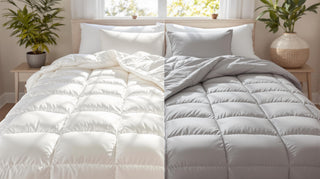Choosing between down and alternative down quilts depends on your priorities like warmth, allergies, maintenance, and budget. Here’s a quick breakdown:
- Down Quilts: Lightweight, excellent insulation, breathable, durable, but expensive and requires special care.
- Alternative Down Quilts: Affordable, hypoallergenic, easy to clean, slightly heavier, and uses synthetic or recycled materials.
Quick Comparison
| Feature | Down Quilts | Alternative Down Quilts |
|---|---|---|
| Warmth | Excellent insulation | Good insulation |
| Breathability | High | Moderate |
| Allergen Risk | Higher | Lower |
| Maintenance | Requires special care | Easy to maintain |
| Durability | 15+ years with proper care | 5-7 years |
| Price | $200-600+ | $50-200 |
| Eco-Friendly | Ethical sourcing available | Recycled options available |
Key Takeaway: Go for down if you want premium warmth and durability. Choose alternative down for affordability, easy care, and allergy-friendly options.
Down vs Down Alternative: Differences (Which Comforter Is Better for YOUR Needs)
1. Down Quilts
Down quilts are prized for their ability to provide natural warmth while staying breathable. This is thanks to the three-dimensional clusters of down that trap heat effectively [2].
The fill power of a down quilt is a key measure of its quality. It shows how many cubic inches one ounce of down can fill. High-end options, like Peacock Alley's European goose down quilts, typically have fill powers ranging from 600 to 800, offering lightweight yet excellent insulation [3].
One major benefit of down quilts is their durability. With proper care, they can retain their loft and insulation for years, making them a smart long-term choice [2].
| Care Aspect | Recommendation |
|---|---|
| Cleaning Method | Professional dry cleaning preferred |
| Protection | Always use a duvet cover |
| Storage | Store in breathable cotton bags |
| Maintenance | Regular fluffing and airing |
To maintain their quality, down quilts should be professionally cleaned, protected with a duvet cover, and stored in breathable bags. Though they can be more expensive due to the labor-intensive process of sourcing down [2], their longevity often justifies the cost.
For those concerned about allergens, many manufacturers now use advanced cleaning methods to minimize allergens without compromising quality [3].
The environmental impact of down quilts depends on how the down is sourced. Products certified by the Responsible Down Standard (RDS) ensure ethical and sustainable practices [3].
Quilts with higher fill powers offer better insulation without adding bulk, making them a versatile option for year-round use in controlled climates [2][4].
While down quilts provide excellent natural warmth and durability, alternative options are available for those prioritizing affordability, ease of care, or hypoallergenic materials.
2. Alternative Down Quilts
Alternative down quilts use synthetic materials like microfiber and polyester to mimic the comfort of natural down while meeting modern preferences. High-quality options such as PrimaLoft® and Dacron® provide excellent insulation and long-lasting performance, rivaling natural down in many aspects [1].
These quilts are especially appealing for those with allergies. Thanks to their hypoallergenic properties, they’re a great choice for individuals with sensitivities [3].
| Feature | Alternative Down | Benefits |
|---|---|---|
| Material | PrimaLoft®/Dacron® | Hypoallergenic, durable |
| Maintenance | Machine washable | Easy to clean, cost-efficient |
| Weight | Slightly heavier | - |
| Price Range | $50-200 | Budget-friendly |
One standout feature is how easy they are to maintain. Alternative down quilts are machine washable and dryer-safe, making them perfect for households seeking low-maintenance bedding [4].
Boll & Branch describes their PrimaLoft® fiber as "offering an experience as close as possible to down", underlining its high quality [1]. Similarly, brands like Peacock Alley have developed advanced options that closely replicate the plush feel of natural down [3].
When it comes to environmental concerns, alternative down quilts are a mixed bag. While synthetic materials can raise questions about resource consumption, recycled options are becoming more common, balancing performance with eco-friendliness [1][3]. These quilts also avoid the animal welfare issues linked to down production, with some manufacturers now incorporating recycled materials into their designs [1][3].
Costing between $50 and $200, alternative down quilts offer an affordable route to comfort and durability [3][4]. While they present a practical option, weighing their benefits and limitations against natural down can help you make the best choice for your needs.
sbb-itb-a5d8867
Advantages and Disadvantages
When it comes to down and alternative down quilts, each has its own strengths and weaknesses, catering to different needs and preferences. Here's a side-by-side comparison:
| Feature | Down Quilts | Alternative Down Quilts |
|---|---|---|
| Warmth & Weight | Lightweight with excellent insulation | Heavier for the same warmth level |
| Breathability | Outstanding natural ventilation | Decent, but not as effective |
| Durability & Care | Lasts 15+ years with proper care, requires dry cleaning | Typically lasts 5-7 years, machine washable |
| Price Range | $200-600+ | $50-200 |
| Allergies | May cause issues for allergy sufferers | Hypoallergenic |
| Environmental Impact | Ethical sourcing concerns | Options with recycled materials available |
Down quilts are known for their ability to provide exceptional warmth while remaining lightweight and breathable. The natural materials used in these quilts offer long-lasting insulation, making them a reliable choice for colder climates [2]. However, they demand extra care and come with a higher price tag.
Alternative down quilts, on the other hand, focus on practicality. They are hypoallergenic, making them suitable for those with sensitivities, and their machine-washable design is perfect for busy households [1]. Advances in synthetic materials have also improved their comfort and performance significantly [3].
Here’s how to decide which is right for you:
- Down quilts are ideal for those who value maximum warmth, breathability, and durability, even if it means higher costs and maintenance.
- Alternative down quilts are a great option for those looking for affordability, easy care, and allergy-friendly features.
Your choice will depend on what matters most to you - whether it’s warmth, low maintenance, or budget. While down quilts excel in insulation and longevity [2][4], alternative down quilts offer practical benefits that fit well into many lifestyles.
Conclusion
Down and alternative down quilts cater to different needs, making them suitable for a variety of preferences and lifestyles. Here's a breakdown to help you decide which option works best for you.
Top brands now use high-quality materials to meet diverse demands - whether you're looking for something luxurious or practical. Traditional down quilts are known for their lightweight warmth and breathability [2], while alternative down quilts have advanced to provide comfort with added convenience [3].
Here are some factors to keep in mind:
- Warmth and Durability: Down quilts with high fill power excel in providing cozy warmth and lasting quality [2].
- Ease of Maintenance: Alternative down quilts are hypoallergenic and easier to clean, making them a practical option [1].
- Cost-Effectiveness: Alternative down offers good insulation at an affordable price.
- Sustainability: Options include recycled alternative down or ethically sourced traditional down [3].
Both materials have seen improvements in comfort and eco-friendliness. Whether your priority is luxury, convenience, or sustainability, the right quilt can make a big difference in your sleep quality.
FAQs
Which is better: down or down alternative?
The choice between down and down alternative depends on your needs and priorities. While natural down is known for its exceptional insulation, alternatives like PrimaLoft offer warmth without overheating [1].
Down alternative is a practical choice for:
- Allergy sufferers: It's hypoallergenic, making it suitable for those sensitive to natural down.
- Easy maintenance: It’s simpler to clean and care for compared to natural down.
- Budget-conscious buyers: It’s generally more affordable.
- Ethical considerations: A great option for those avoiding animal-derived products.
On the other hand, natural down stands out for its durability, excellent insulation, and luxurious feel. European white goose down, for example, is highly regarded for its long-lasting quality and plush comfort [2]. Its superior warmth-to-weight ratio and natural loft make it a premium option.
While down alternatives have improved in comfort and affordability over time [3], they don’t quite match the luxury and performance of natural down. Your decision should be guided by factors like budget, maintenance preferences, and whether hypoallergenic or ethical considerations are important to you. Both options cater to different lifestyles and needs.

